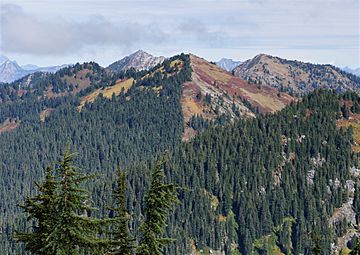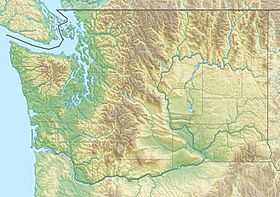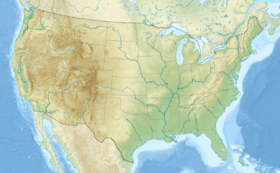Jove Peak facts for kids
Quick facts for kids Jove Peak |
|
|---|---|

Southwest aspect from Mt. McCausland
|
|
| Highest point | |
| Elevation | 6,007 ft (1,831 m) |
| Prominence | 647 ft (197 m) |
| Isolation | 2.07 mi (3.33 km) |
| Parent peak | Labyrinth Mountain (6,376 ft) |
| Geography | |
| Location | Snohomish County / Chelan County Washington, U.S. |
| Parent range | North Cascades Cascade Range |
| Topo map | USGS Labyrinth Mountain |
| Type of rock | Orbiculite |
| Climbing | |
| Easiest route | scrambling South ridge |
Jove Peak is a tall mountain in Washington state. It stands about 6,007 feet (1,831 meters) high. This peak is located about 5 miles (8 kilometers) north of Stevens Pass. It sits right on the border between Snohomish County and Chelan County.
Jove Peak is found in a wild area called the Henry M. Jackson Wilderness. It's part of lands managed by the Mount Baker-Snoqualmie National Forest and Okanogan-Wenatchee National Forest. A person named Albert Hale Sylvester gave Jove Peak its name. He named it after Jove, another name for the Roman god Jupiter. This fits with the names of nearby places like Minotaur and Theseus Lakes. These lakes are close to Labyrinth Mountain, which is about 2.5 miles (4 kilometers) to the northeast. Water from Jove Peak flows into the Rapid River to the west. It also drains into Rainy Creek to the east, which then joins the Little Wenatchee River.
Weather and Climate Around Jove Peak
Jove Peak is in a climate zone called the marine west coast climate. This means it gets a lot of moisture from the Pacific Ocean. Most weather systems come from the Pacific and move east. When these systems hit the Cascade Mountains, the air is forced upwards. This process, called orographic lift, makes the air cool down. As it cools, it drops its moisture as rain or snow onto the mountains.
Because Jove Peak is on the Cascade crest, it gets a lot of rain and especially snow. Winters are usually cloudy and snowy. However, in summer, high-pressure systems over the Pacific often bring clear skies. Sometimes, summer can also bring thunderstorms. The best time to visit or climb Jove Peak is usually from July to September. But if you like skiing, Jove Peak is also a great spot in winter!
How Jove Peak Was Formed
The North Cascades mountains, where Jove Peak is located, have very rugged shapes. You can see sharp peaks, long ridges, and deep valleys carved by glaciers. These amazing landscapes were created by geological events that happened millions of years ago. These events caused big changes in elevation and led to different climates across the Cascade Range.
The Cascade Mountains started forming millions of years ago, during the late Eocene Epoch. This happened because the North American Plate was slowly moving over the Pacific Plate. This movement caused a lot of volcanic activity. For example, Glacier Peak, a large volcano about 20 miles (32 kilometers) north of Jove Peak, began forming in the mid-Pleistocene. Also, small pieces of the Earth's crust, called terranes, helped build the North Cascades about 50 million years ago.
During the Pleistocene period, which started over two million years ago, glaciers played a huge role. These massive ice sheets moved forward and backward many times. As they moved, they carved and shaped the land. Most valleys were free of ice by about 12,000 years ago. The combination of the land being pushed upwards (uplift) and cracks forming in the Earth's crust (faulting) along with glaciation created the tall peaks and deep valleys we see today in the North Cascades.




